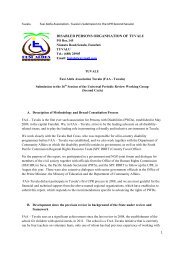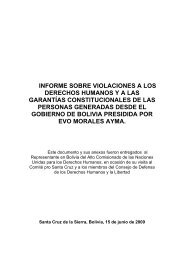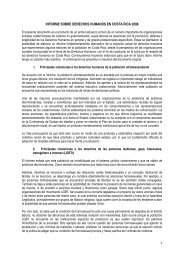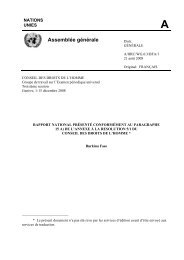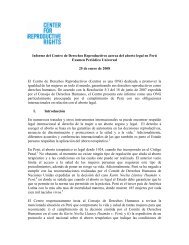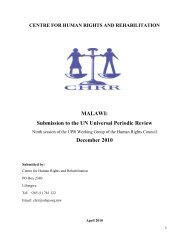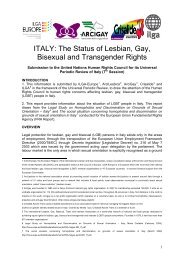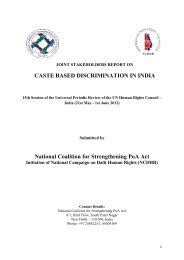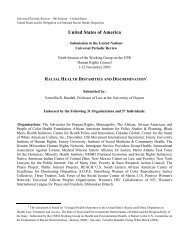Prison Needle Exchange: Lessons from a Comprehensive Review ...
Prison Needle Exchange: Lessons from a Comprehensive Review ...
Prison Needle Exchange: Lessons from a Comprehensive Review ...
Create successful ePaper yourself
Turn your PDF publications into a flip-book with our unique Google optimized e-Paper software.
67 R Keppler, F Nolte, H Stöver.Transmission of infectious diseases in prisons – results of a study for women in Vechta, Lower<br />
Saxony, Germany. Sucht 1996; 42: 98-107 at 104.<br />
68 LM Calzavara,AN Burchell, J Schlossberg,T Myers, M Escobar, E Wallace, C Major, C Strike, M Millson. Prior opiate injection and<br />
incarceration history predict injection drug use among inmates. Addiction 2003; 98(9): 1257-1265.<br />
69 A DiCenso et al. Unlocking Our Futures: A National Study on Women, <strong>Prison</strong>s, HIV, and Hepatitis C.Toronto: <strong>Prison</strong>ers’ HIV/AIDS<br />
Support Action Network, 2003.<br />
70 PM Ford et al. HIV and hep C seroprevalence and associated risk behaviours in a Canadian prison. Canadian HIV/AIDS Policy &<br />
Law Newsletter 1999; 4(2/3): 52-54.<br />
71 T Nichol. Bleach Pilot Project. Second unpublished account of the introduction of bleach at Matsqui Institution, dated 28 March<br />
1996. Cited in Jürgens, supra, note 47.<br />
72 1995 National Inmate Survey, supra, note 46.<br />
73 C Hankins et al. Prior risk factors for HIV infection and current risk behaviours among incarcerated men and women in mediumsecurity<br />
correctional institutions – Montreal. Canadian Journal of Infectious Diseases 1995; 6(Suppl B): 31B. Cited in Jürgens, supra,<br />
note 47.<br />
74 A Dufour et al. HIV prevalence among inmates of a provincial prison in Quebec City. Canadian Journal of Infectious Diseases 1995;<br />
6(Suppl B): 31B. Cited in Jürgens, supra, note 47.<br />
75 E Single. Harm reduction as the basis for hepatitis C policy and programming. Presentation at First Canadian Conference on<br />
Hepatitis C, Montréal, Canada, 4 May 2001.<br />
76 Lines, supra, note 18.<br />
77 Joint United Nations Programme on HIV/AIDS (UNAIDS). <strong>Prison</strong>s and AIDS: UNAIDS Technical Update. Geneva: UNAIDS,April<br />
1997, at 3.Available online via www.unaids.org.<br />
78 Vienna Declaration and Programme of Action, adopted 25 June 1993.World Conference on Human Rights. UN GA Doc<br />
A/CONF/137/23.<br />
79 International Covenant on Civil and Political Rights. UN GA res 2200A (XXI), 21 UN GAOR Supp (No 16) at 52, UN Doc<br />
A/6316 (1966), 999 UNTS 171, entered into force 23 March 1976.<br />
80 International Covenant on Economic, Social and Cultural Rights. UN GA res 2200A (XXI), 21 UN GAOR Supp (No 16) at 49,<br />
UN Doc A/6316 (1966), 993 UNTS 3, entered into force 3 January 1976.<br />
81 African Charter on Human and Peoples’ Rights. OAU Doc CAB/LEG/67/3 rev 5, 21 ILM 58 (1982), adopted 27 June 1981,<br />
entered into force 21 October 1986.<br />
82 American Convention on Human Rights. OAS Treaty Series No 36, 1144 UNTS 123, entered into force 18 July 1978.<br />
83 Additional Protocol to the American Convention on Human Rights in the Area of Economic, Social and Cultural Rights. OAS<br />
Treaty Series No 69 (1988), signed 17 November 1988.<br />
84 [European] Convention for the Protection of Human Rights and Fundamental Freedoms. ETS 5, 213 UNTS 222, entered into<br />
force 3 September 1953, as amended by Protocols Nos 3, 5, and 8, which entered into force on 21 September 1970, 20 December<br />
1971, and 1 January 1990 respectively.<br />
85 European Social Charter. ETS 35, 529 UNTS 89, entered into force 26 February 1965.<br />
86 Universal Declaration of Human Rights. UN GA res 217A (III), UN Doc A/810 at 71 (1948).<br />
87 According to the principle of customary international law, the standards and norms contained in declarations are acknowledged<br />
among the community of nations as establishing binding law.The question of what is included in customary international law is a<br />
question of fact and usage. Customary international law is law that becomes binding on states out of custom when enough states<br />
have begun to behave as though something is law, and does not require the laws to be written.<br />
88 See generally Jürgens, supra, note 47 at 85-86. Specifically, Principle 5 of the UN Basic Principles for the Treatment of <strong>Prison</strong>ers<br />
states that “Except for those limitations that are demonstrably necessitated by the fact of incarceration, all prisoners shall retain<br />
the human rights and fundamental freedoms set out in the Universal Declaration of Human Rights, and … the International Covenant on<br />
Economic, Social and Cultural Rights, and the International Covenant on Civil and Political Rights … as well as such other rights as are set<br />
out in other United Nations covenants.” Adopted by General Assembly Resolution 45/111, annex, 45 UN GAOR Supp (No 49A) at<br />
200, UN Doc A/45/49 (1990).<br />
89 S Shaw. <strong>Prison</strong>ers’ Rights. In: P Seighart (ed). Human Rights in the United Kingdom. London: Pinter Publishers, 1988, at 42.<br />
90 Basic Principles, supra, note 88.<br />
91 Body of Principles for the Protection of All Persons under Any Form of Detention or Imprisonment. UN GA res 43/173, annex,<br />
Notes 71



